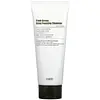What's inside
What's inside
 Key Ingredients
Key Ingredients

 Benefits
Benefits

 Concerns
Concerns

 Ingredients Side-by-side
Ingredients Side-by-side

Water
Skin ConditioningSodium Laureth Sulfate
CleansingCocamide DEA
EmulsifyingCocamidopropyl Betaine
CleansingDisodium Cocoyl Glutamate
CleansingLauryl Glucoside
CleansingAloe Barbadensis Leaf
MaskingBenzoic Acid
MaskingBisabolol
MaskingCaprylyl Glycol
EmollientCitric Acid
BufferingParfum
MaskingGlutaral
PreservativeMaltodextrin
AbsorbentPEG-120 Methyl Glucose Dioleate
EmulsifyingSodium Benzoate
MaskingSodium Chloride
MaskingSodium PCA
HumectantTocopherol
AntioxidantWater, Sodium Laureth Sulfate, Cocamide DEA, Cocamidopropyl Betaine, Disodium Cocoyl Glutamate, Lauryl Glucoside, Aloe Barbadensis Leaf, Benzoic Acid, Bisabolol, Caprylyl Glycol, Citric Acid, Parfum, Glutaral, Maltodextrin, PEG-120 Methyl Glucose Dioleate, Sodium Benzoate, Sodium Chloride, Sodium PCA, Tocopherol
Water
Skin ConditioningSodium Cocoyl Isethionate
CleansingGlycerin
HumectantLauric Acid
CleansingSodium Methyl Cocoyl Taurate
CleansingPropanediol
SolventHydroxypropyl Starch Phosphate
Coco-Betaine
CleansingGlyceryl Stearate
EmollientSodium Chloride
MaskingSodium Benzoate
MaskingPolyquaternium-10
Citric Acid
BufferingCoconut Acid
CleansingCaprylyl Glycol
EmollientButylene Glycol
Humectant1,2-Hexanediol
Skin ConditioningVaccinium Macrocarpon Fruit Extract
AstringentAdansonia Digitata Fruit Extract
EmollientOlea Europaea Leaf Extract
PerfumingEquisetum Arvense Extract
AstringentCamellia Sinensis Leaf Extract
AntimicrobialNymphaea Alba Flower Extract
Skin ConditioningSophora Japonica Root Extract
Skin ProtectingDisodium EDTA
Water, Sodium Cocoyl Isethionate, Glycerin, Lauric Acid, Sodium Methyl Cocoyl Taurate, Propanediol, Hydroxypropyl Starch Phosphate, Coco-Betaine, Glyceryl Stearate, Sodium Chloride, Sodium Benzoate, Polyquaternium-10, Citric Acid, Coconut Acid, Caprylyl Glycol, Butylene Glycol, 1,2-Hexanediol, Vaccinium Macrocarpon Fruit Extract, Adansonia Digitata Fruit Extract, Olea Europaea Leaf Extract, Equisetum Arvense Extract, Camellia Sinensis Leaf Extract, Nymphaea Alba Flower Extract, Sophora Japonica Root Extract, Disodium EDTA
 Reviews
Reviews

Ingredients Explained
These ingredients are found in both products.
Ingredients higher up in an ingredient list are typically present in a larger amount.
Caprylyl Glycol is a humectant and emollient, meaning it attracts and preserves moisture.
It is a common ingredient in many products, especially those designed to hydrate skin. The primary benefits are retaining moisture, skin softening, and promoting a healthy skin barrier.
Though Caprylyl Glycol is an alcohol derived from fatty acids, it is not the kind that can dry out skin.
This ingredient is also used as a preservative to extend the life of products. It has slight antimicrobial properties.
Learn more about Caprylyl GlycolCitric Acid is an alpha hydroxy acid (AHA) naturally found in citrus fruits like oranges, lemons, and limes.
Like other AHAs, citric acid can exfoliate skin by breaking down the bonds that hold dead skin cells together. This helps reveal smoother and brighter skin underneath.
However, this exfoliating effect only happens at high concentrations (20%) which can be hard to find in cosmetic products.
Due to this, citric acid is usually included in small amounts as a pH adjuster. This helps keep products slightly more acidic and compatible with skin's natural pH.
In skincare formulas, citric acid can:
While it can provide some skin benefits, research shows lactic acid and glycolic acid are generally more effective and less irritating exfoliants.
Most citric acid used in skincare today is made by fermenting sugars (usually from molasses). This synthetic version is identical to the natural citrus form but easier to stabilize and use in formulations.
Read more about some other popular AHA's here:
Learn more about Citric AcidSodium Benzoate is a preservative. It's used in both cosmetic and food products to inhibit the growth of mold and bacteria. It is typically produced synthetically.
Both the US FDA and EU Health Committee have approved the use of sodium benzoate. In the US, levels of 0.1% (of the total product) are allowed.
Sodium benzoate works as a preservative by inhibiting the growth of bacteria inside of cells. It prevents the cell from fermenting a type of sugar using an enzyme called phosphofructokinase.
It is the salt of benzoic acid. Foods containing sodium benzoate include soda, salad dressings, condiments, fruit juices, wines, and snack foods.
Studies for using ascorbic acid and sodium benzoate in cosmetics are lacking, especially in skincare routines with multiple steps.
We always recommend speaking with a professional, such as a dermatologist, if you have any concerns.
Learn more about Sodium BenzoateChances are, you eat sodium chloride every day. Sodium Chloride is also known as table salt.
This ingredient has many purposes in skincare: thickener, emulsifier, and exfoliator.
You'll most likely find this ingredient in cleansers where it is used to create a gel-like texture. As an emulsifier, it also prevents ingredients from separating.
There is much debate on whether this ingredient is comedogenic. The short answer - comedogenic ratings don't tell the whole story. Learn more about comegodenic ratings here.
The concensus about this ingredient causing acne seems to be divided. Research is needed to understand if this ingredient does cause acne.
Scrubs may use salt as the primary exfoliating ingredient.
Learn more about Sodium ChlorideWater. It's the most common cosmetic ingredient of all. You'll usually see it at the top of ingredient lists, meaning that it makes up the largest part of the product.
So why is it so popular? Water most often acts as a solvent - this means that it helps dissolve other ingredients into the formulation.
You'll also recognize water as that liquid we all need to stay alive. If you see this, drink a glass of water. Stay hydrated!
Learn more about Water